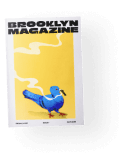Photo by Angelina Katsanis via Getty Images
2025 New York General Election: Everything You Need to Know to Vote in Brooklyn
The mayoral race may be the big show of this year's election, but there's a whole lot more you can expect to see on the ballot
Days out from the 2025 New York general election, hundreds of thousands of you have already cast your ballots for how the machine runs and who gets to maintain it in the city, but also across the entirety of the Empire State. However, statistically, there’s a good chunk of you (no judgment here) who are probably still trying to piece together not just the logistics of voting in Kings County, but who and what else to expect on the ballots. After all, in a city that never stops moving, our ballots are one of the few moments we get to say: this matters.
This year, New Yorkers will decide on who handles the housing crunch, who stewards the budget, and who draws the map of their neighborhood’s future. But if you’ve been following the very loud and chaotic (and, admittedly, pretty entertaining) mayoral showdown, you might just think that’s all there is to this election cycle. And if that’s the case, you’d be painfully wrong. So, we’ve been sifting through the debris flying out of the local races to make sure you know what you’re up against (and, more importantly, for) when you do eventually (hopefully) hit the booths.
Here’s everything you need to know about voting in the 2025 New York general election in Brooklyn.
When is Election Day?
Election Day in New York is, and god-willing will always be, on the same day every election cycle, which is November 4.
Where do I vote in Brooklyn?
Your polling location and who you get to vote for in the 2025 general election depend on where exactly you live in the five boroughs. Luckily, the Board of Elections can get you sorted in a hurry. Head over to their site to find your booth today.
When do polls open and close in Brooklyn?
Early voting in NYC runs through November 2, taking Monday to cool off before the big day. Polling locations across the borough are open from 9 a.m. to 5 p.m. on November 1 and 2. But you’ll have the widest window on Election Day proper, when polling locations open at 6 a.m. and shut down at 9 p.m.
Who’s running for mayor?
If you’ve been in proximity to a screen of any size at all over the last few months, there’s a solid chance you’re already pretty familiar with this year’s contenders for Mayor. But just so we’re clear, three names remain on the ballot, none of them are Eric Adams. On the Democratic ticket, there’s 33-year-old Queens assemblyman and current frontrunner Zohran Mamdani. In the Independent column, there’s Mamdani’s former party rival Andrew Cuomo, hoping round two will go better than the first. And finally, there’s Curtis Sliwa, the perennial Republican candidate, who founded the red-beret vigilante crime-fighting group “Guardian Angels.”
Who else is running this year?
The mayoral race may be the big show of this election, but there are literally hundreds of other candidates running for positions just as vital to the health of the city this year.
Down the ballot, you’ll find incumbent Jumaane Williams looking to retain his position as Public Advocate, running against Republican candidate Gonzalo Duran and “Unity Party” rep Martin Dolan. Looking to replace Brad Lander as City Comptroller are Democratic candidate Mark Levine, Republican Peter Kafalas, and the Unity Party’s Ismael Perez.
Each borough’s president is also defending their seat. In Brooklyn, Antonio Reynoso is squaring up with Janina Acquafredda. In Manhattan, it’s a three-way race between Democrat Brad Hoylman-Sigal, Republican Seson Adams, and the Unity Party’s Rolando Gomez. In Queens, Democratic candidate Donovan Richards and Republican Henry Ikezi are contending for the top spot in the world’s borough. In the Bronx, Democrat and Working Families Party rep Vanessa Gibson is taking on Republican Grace Marrero. And, finally, in Staten Island, Democratic candidate Michael Colombo is facing off against Republican Vito Fossella.
There’s also the matter of all those City Council seats, for which there are way too many candidates running in all 51 city districts. For a breakdown of who you’ll see on your ballot, based on which district you live in, head over to NYC Votes, where you can also find the party and policy points of each and every name you’ve seen here today.
What about these ballot proposals?
Proposal 1: Giving the Adirondacks an Olympic complex, but also 2,500+ acres of newly protected land
Albany previously approved the development of an Olympic stadium and ski complex on 323 acres of protected land in the Adirondacks. Voting “yes” on this proposal would retroactively authorize that expansion in exchange for 2,500 acres of additional protected lands in other parts of the state.
Proposal 2: Fast-tracking affordable housing
Currently, the City Council makes the final call on all affordable housing projects in the five boroughs. Voting in favor of this proposal would effectively pull some of the bumpers from the approval process by creating two review paths for new affordable housing projects: one for those publicly funded and another “fast track” option that no longer requires City Council’s review for privately funded, permanently affordable housing in the 12 neighborhoods that have built the least of it.
Proposal 3: Expediting “Expedited Review”
This proposal establishes a new procedure for “Expedited Review,” the process by which smaller development projects can get taped up and tossed into a drawer for decades. If it passes, the city will remove said tape from proposals that require “modest zoning changes,” but mandate that each developer dedicate a portion of its project to permanently affordable housing.
Proposal 4: Establishing an Affordable Housing Appeals Board
It’s not entirely clear how this one will interact with the two-lane approval highway the second proposal would establish if passed, but it essentially creates a three-person committee—made up of the Mayor, the City Council Speaker, and the president of whichever borough is impacted—to be the final say on any affordable housing projects that go through the full Uniform Land Use Review Procedure (which is many of them).
Proposal 5: Finally digitizing the city map
It may seem crazy—because, frankly, it absolutely is—but the city has never had a unified central map. Instead, it relies on each borough president to keep, maintain, and refer to their own paper maps when reviewing any housing, infrastructure, or land use projects. This proposal does the unthinkable and consolidates all 8,000 or so paper maps in rotation into one digitized map overseen by the Department of City Planning.
Proposal 6: Time-shifting the mayoral election
The final proposal on this year’s ballot is pretty cut and dry—it pushes the mayoral election into even years, in an effort to align voting for whoever’s in the city’s highest office with the federal election cycle. But this electoral time-shift is more contentious than it could ever present, with advocates hoping it would improve voter turnout and opponents fearing the pitch, decibel level, and general rucus of national political campaigns could actually have the opposite effect, and make it more difficult for voters to discern the differences between candidates and policies in local elections.
You might also like 























